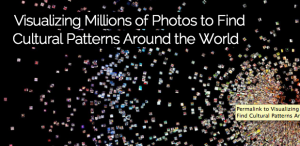The Software is the Message
In a mini article of his, new media theorist Lev Manovich rephrased Marshall McLuhan’s most famous sentence by replacing the word ‘medium’ with the word ‘software’, saying that: “The software is the message”. For Manovich, software is an universal engine which the world runs on. According to him, it must not be seen as simply a new object that can be studied on its own, but rather as a new layer, or extra dimension of an existing object. One that “re-adjusts and re-shapes everything it is applied to – or at least, it has the potential to do this”. And because software is ubiquitous in culture, I think that it is not only an optional dimension for cultural studies, it is a highly crucial one.
Earlier on, there were ‘texts’, like a book, movie or music track for example, that could be analyzed for the purpose of cultural research. These rather static objects could be analyzed, placing them in context according to difference in cultural or periodic origin. In today’s software culture, however, every cultural object is now subject to the workings of software which are highly influential. So instead of static ‘texts’, we now have software performances argues Manovich. He calls them so, because “what we are experiencing is constructed by software in real time and therefore we are engaging with the dynamic outputs of computation”. Because of this radical and complex change of culture’s character, the way we do research must also be critically reviewed and re-adjusted to work optimal with these software performances.
Lev Manovich is really trying to capture these new kinds of cultural research. He is one of the pioneers of the emerging interdisciplinary research field called software studies, which studies the effects that software has on cultural production and everyday life (Fuller, 2003; Kitchin and Dodge, 2011; Manovich, 2008). This new kind of research gives more attention to the role of software than previously was the case. “Software is often a blind spot in the theorization and study of computational and networked digital media”, Fuller wrote when introducing the first Software Studies workshop in Rotterdam, 2006. Also, according to Manovich, software studies must not only investigate the role of software in forming contemporary culture, but also investigate cultural, social, and economic forces that are shaping development of software itself. Because all software is developed by actual human beings, it is also subject to specific cultural development and design choices. For example, the interface of the current iPhone is the result of years of market research, customer experiences with previous interfaces and other factors. Therefore, the interface is also a product of cultural, social and economic forces.
In 2007, Manovich started the Software Studies Initiative at the University of California at San Diego. Here, they are primarily focussed on the production and usage of visual media and especially to what extend software influences these processes. In their Phototrails project, for example, they visualized patterns in the use of Instagram across 2.3 million photos from 13 global cities. This study researched both the influence of software interfaces on what we do, while at the same time studying large-scale behaviours of many software users. The key question for this study was: how much differs the use of Instagram from city to city, given that they all use the same software and interface. There were small, but systematic differences in the photos, but the use of the Instagram software itself was remarkebly consistent.
To conclude this blogpost, I would like to return to Manovich rephrasing McLuhan one more time. I think it is safe to assume that software is a very ubiquitous thing these days. Not only playing a major role in media, but in all sorts of daily activities. In this respect, software is a perfect example of what McLuhan meant when he wrote that the “message of any medium or technology is the change of scale or pace or pattern that it introduces into human affairs.” When incorporating software studies into cultural research, a whole new world opens up and new patterns will arise. Data visualization is an excellent example of this. And because a software process is, rather than a static text, always in motion, I am now able to endlessly re-fashion this blogpost. So when I’d like to change the content of this post or WordPress comes with an update where I can fancy up this one, I could possibly do so.. “Welcome to the world of permanent change – a world defined not by heavy industrial machines that are modified infrequently, but by software that is always in flux.” (Manovich, 2013)
Suggested readings:
- Manovich, Lev. The language of new media. MIT press, 2001.
- Manovich, Lev. Software takes command. Vol. 5. A&C Black, 2013.
- Kitchin, Rob, and Martin Dodge. Code/space: Software and everyday life. MIT Press, 2011.
- Fuller, Matthew. “Behind the blip: Essays on the culture of software.” (2003).
Manovich about the Software Studies Initiative:

